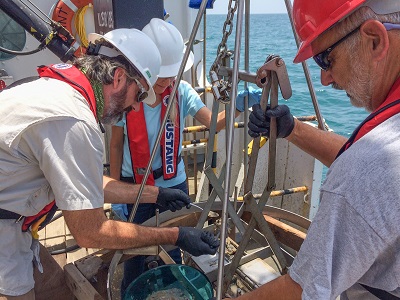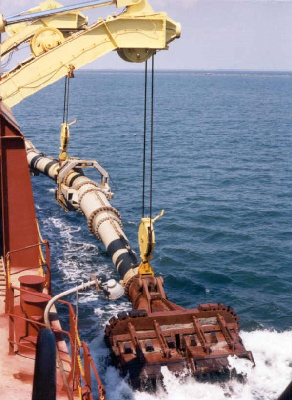Managing Ocean Dumping in EPA Region 6

Region 6’s Ocean Dumping Management Program plays an essential role in keeping our oceans safe and clean, while supporting the marine transportation system and the economy. Region 6 serves Arkansas, Louisiana, New Mexico, Oklahoma, Texas and 66 tribes. Region 6 encompasses the ocean waters offshore of Louisiana and Texas.
On this page:
- Announcements
- Ocean Dumping Permits (for materials other than dredged material)
- Ocean Disposal of Fish Wastes
- Ocean Disposal of Dredged Material in Region 6
- Dredged Material Testing for Ocean Disposal in Region 6
- Ocean Disposal Sites in Region 6
- Regional Dredging Teams and Other Partnerships
- Beneficial Use
Announcements
There are no announcements at this time.
Ocean Dumping Permits
Under the Marine Protection, Research and Sanctuaries Act (MPRSA), EPA is the permitting agency for the ocean disposal of all materials except dredged material. The U.S. Army Corps of Engineers (USACE) is the permitting agency for ocean disposal of dredged material. See below for additional information about ocean disposal of dredged material. EPA has issued MPRSA general permits for the ocean dumping of certain materials that may have a minimal adverse environmental impact and are generally disposed of in small quantities. In rare instances, EPA Regional Offices may issue an emergency, research or special ocean dumping permit to an individual or entity.
EPA Region 6 provides localized support and implements the following MPRSA general permits to ensure responsible disposal of wastes and other materials in their ocean waters:
- Burial at Sea of cremated or non-cremated human remains. Reports must be submitted to EPA Region 6.
- Disposal of Vessels at Sea -- Requires consultation with EPA Region 6.
- Ocean Disposal of Marine Mammal Carcasses -- Requires consultation with EPA Region 6.
Please visit our Ocean Dumping Permits Web page for additional information.
Ocean Disposal of Fish Wastes
For information about the disposal of fish wastes in ocean waters, please see our Disposal of Fish Wastes Web page.
Ocean Disposal of Dredged Material in Region 6

The regulation of dredged material disposal in ocean waters is a shared responsibility of Region 6 and the USACE Southwestern and Mississippi Valley Divisions.
Under the MPRSA, USACE is the federal agency that decides whether to issue a permit authorizing the ocean disposal of dredged materials or authorize federal navigation projects involving ocean disposal of dredged materials. USACE relies on EPA’s ocean dumping criteria when evaluating permit requests for (and implementing federal projects involving) the transportation of dredged material for the purpose of dumping it into ocean waters. EPA’s ocean dumping criteria consider, among other things:
- the need for dumping;
- the environmental impact of the dumping, including the effect of dumping on marine ecosystems, shorelines and beaches;
- the effect of the dumping on esthetic, recreational or economic values;
- the adverse effect of dumping on other uses of the ocean including navigation, scientific study, fishing and resource exploitation activities; and
- appropriate locations and methods of disposal or recycling, including land-based alternatives.
All MPRSA permits for dredged material disposal in ocean waters, and federal projects involving dredged material disposal in ocean waters, are subject to EPA review and written concurrence. EPA may concur, concur with conditions, or decline to concur (i.e., non-concur) on the proposed permit. If EPA concurs with conditions, the final permit issued by USACE must include those conditions (for example, ocean disposal site use conditions). If EPA declines to concur on the proposed permit, the permit cannot be issued. The USACE-led review and permitting process is facilitated by early coordination, including review and approval of the sampling and analysis plan, ensuring full characterization of the project sediments proposed to be dredged.
For additional information about MPRSA permits and federal projects involving dredged material, please see Ocean Disposal of Dredged Material Web page.
Dredged Material Testing for Ocean Disposal in Region 6
Evaluation of dredged material for ocean disposal under the MPRSA relies largely on biological tests, using standardized procedures and test organisms, also referred to as bioassays. The ocean testing manual, also known as the “Green Book,” provides national technical guidance for determining the suitability of dredged material for ocean disposal through chemical, physical and biological evaluations. The technical guidance is intended for use by dredging applicants, laboratory scientists, and regulators. Regional guidance is provided in the Regional Implementation Agreement.
For more information regarding dredged material testing, including additional guidance documents, please visit our Testing and Evaluation Web page.
Ocean Disposal Sites in Region 6
EPA Region 6 is responsible for designating and managing ocean disposal sites for all types of materials in the Region. Appropriate management of ocean dumping sites is aimed at assuring that disposal activities will not unreasonably degrade or endanger human health and welfare, the marine environment or cause excessive economic impacts. All currently designated ocean sites in Region 6 are for the disposal of dredged material permitted or authorized under the MPRSA. Each ocean disposal site must have a site management and monitoring plan (SMMP). Region 6, in collaboration with the USACE, is responsible for developing SMMPs for ocean dredged material disposal sites.
Region 6, often in coordination with USACE, monitors ocean dredged material disposal sites. Monitoring surveys may include, but are not limited to:
- sediment analysis for physical properties;
- sediment analysis for chemical contamination;
- benthic infaunal community analysis;
- remote-sensing surveys including multibeam surveys and side-scan sonar surveys;
- sediment profile imagery, and
- benthic trawls.
Please visit our Ocean Disposal Map and Ocean Disposal Sites Web pages to view a national map of ocean disposal sites and to learn more about site management and monitoring under the MPRSA.
The orange points in the map below show Region 6's ocean disposal sites offshore of Louisiana and Texas.
Descriptions of the ocean disposal sites, site management and monitoring plans, and monitoring results in Region 6 are provided below.
Louisiana Disposal Sites
Atchafalaya River and Bayous Chene, Boeuf, and Black, LA (ODMDS- East)
Location: 29⁰20.998’ N, 91⁰23.553’ W; 29⁰20.732’ N, 91⁰23.162’ W; 29⁰08.257’ N, 91⁰34.850’ W; 29⁰7.990’ N, 91⁰34.458’ W (NAD 83)
Size: 6.90 square nautical miles
Depth: Average 16.00 feet
Use: Dredged material disposal
Management Plan: Atchafalaya River and Bayous Chene, Boeuf, and Black SMMP (pdf)
Atchafalaya River and Bayous Chene, Boeuf, and Black, LA (ODMDS- West)
Location: 29⁰22.100’ N, 91⁰27.633’ W; 29⁰20.500’ N, 91⁰25.216’ W; 29⁰09.266’ N, 91⁰35.200’ W; 29⁰10.866’ N, 91⁰37.550’ W (NAD 83)
Size: 36.25 square nautical miles
Depth: 4- 23 feet
Use: Dredged material disposal
Management Plan: Atchafalaya River and Bayous Chene, Boeuf, and Black SMMP (pdf)
Barataria Bay Waterway, LA
Location: 29⁰16.1802’ N, 89⁰56.3376’ W; 29⁰14.3302’ N, 89⁰53.2708’ W; 29⁰14.0136’ N, 89⁰53.6042’ W; 29⁰16.4969’ N, 89⁰55.9876’ W (NAD83)
Size: 1.40 square nautical miles
Depth: 8- 20 feet
Use: Dredged material disposal
Management Plan: Barataria Bay Waterway SMMP (pdf)
Calcasieu, LA Dredged Material Site 1
Location: 29⁰45.6633’ N, 93⁰19.6092’ W; 29⁰42.7134’ N, 93⁰19.1092’ W; 29⁰42.6135’ N, 93⁰19.8092’ W; 29⁰44.7134’ N, 93⁰20.2092’ W; 29⁰44.7134’ N, 93⁰20.4092’ W; 29⁰45.4633’ N, 93⁰20.5592’ W (NAD 83)
Size: 1.76 square nautical miles
Depth: 6.56- 26.25 feet
Use: Dredged material disposal
Management Plan: Calcasieu River and Pass SMMP (pdf)
Calcasieu, LA Dredged Material Site 2
Location: 29⁰44.5300’ N, 93⁰20.7258’ W; 29⁰39.7636’ N, 93⁰19.9426’ W; 29⁰39.5803’ N, 93⁰20.7759’ W; 29⁰44.4301’ N, 93⁰21.5592’ W (NAD83)
Size: 3.53 square nautical miles
Depth: 6.56- 36.09 feet
Use: Dredged material disposal
Management Plan: Calcasieu River and Pass SMMP (pdf)
Calcasieu, LA Dredged Material Site 3
Location: 29⁰37.8470’ N, 93⁰19.6259’ W; 29⁰37.4304’ N, 93⁰19.5593’ W; 29⁰33.9305’ N, 93⁰16.3926’ W; 29⁰33.8305’ N, 93⁰16.4260’ W; 29⁰30.9973’ N, 93⁰13.8593’ W; 29⁰29.1807’ N, 93⁰13.8260’ W; 29⁰29.0973’ N, 93⁰14.3927’ W; 29⁰30.8306’ N, 93⁰14.4260’ W; 29⁰37.4470’ N, 93⁰20.4093’ W; 29⁰37.7470’ N, 93⁰20.4593’ W (NAD83)
Size: 5.88 square nautical miles
Depth: 36.09- 45.93 feet
Use: Dredged material disposal
Management Plan: Calcasieu River and Pass SMMP (pdf)
Southwest Pass Mississippi River, LA
Location: 28⁰54.200’ N, 89⁰27.250’ W; 28⁰54.200’ N, 89⁰26.000’ W; 28⁰51.000’ N, 89⁰27.250’ W; 28⁰51.000’ N, 89⁰26.000’ W (NAD 83)
Size: 3.44 square nautical miles
Depth: 8.86- 105.64 feet
Use: Dredged material disposal
Management Plan: Southwest Pass SMMP (pdf)
Texas Disposal Sites
Brazos Island Harbor, TX Maintenance Site
Location: 26⁰04.5546’ N, 97⁰07.4481’ W; 26⁰04.5546’ N, 97⁰06.5148’ W; 26⁰04.0546’ N, 97⁰06.5148’ W; 26⁰04.0546’ N, 97⁰07.4481’ W (NAD83)
Size: 0.42 square nautical miles
Depth: 55-65 feet
Use: Dredged material disposal
Management Plan: Brazos Island Harbor SMMP (pdf)
Brazos Island Harbor, TX New Work Site
Location: 26⁰04’48.28032" N, 97⁰05’7.88508" W; 26⁰05’17.27967" N, 97⁰05’4.88510" W; 26⁰05’11.27958" N, 97⁰04’6.88269" W; 26⁰04’43.28022" N, 97⁰04’9.88266" W (NAD83)
Size: 0.42 square nautical miles
Depth: 60-67 feet
Use: Dredged material disposal
Management Plan: Brazos Island Harbor SMMP (pdf)
Corpus Christi New Work ODMDS (formerly Homeport Project ODMDS)
Location: 27⁰27.7191’ N, 97⁰0.2156’W; 27⁰47.2684’ N, 96⁰59.4325’ W; 27⁰46.3017’ N, 97⁰1.2159’ W; 27⁰45.8351’ N, 97⁰11.4326’ W (NAD83)
Size: 1.40 square nautical miles
Depth: 45- 55 feet
Use: Dredged material disposal
Monitoring Reports:
Corpus Christi Ship Channel, TX
Location: 27⁰49.1849’ N, 97⁰01.1659’ W; 27⁰48.7183’ N, 97⁰00.3659’ W; 27⁰48.1183’ N, 97⁰00.8159’ W; 27⁰48.5683’ N, 97⁰01.6159’ W (NAD83)
Size: 0.63 square nautical miles
Depth: 35- 50 feet
Use: Dredged material disposal
Management Plan: Corpus Christi Ship Channel SMMP (pdf)
Freeport Harbor, TX Maintenance
Location: 28⁰54.0149’ N, 95⁰15.8295’ W; 28⁰53.4816’ N, 95⁰15.2794’ W; 28⁰52.0150’ N, 95⁰16.9962’ W; 28⁰52.5483’ N, 95⁰17.5462’ W (NAD83)
Size: 1.53 square nautical miles
Depth: 31- 38 feet
Use: Dredged material disposal
Management Plan: Freeport Harbor SMMP (pdf)
Freeport Harbor, TX New Work
Location: 28⁰50.8650’ N, 95⁰13.9127’ W; 28⁰51.7483’ N, 95⁰14.8294’ W; 28⁰50.2650’ N, 95⁰16.6795’ W; 28⁰49.3817’ N, 95⁰15.7628’ W (NAD83)
Size: 2.64 square nautical miles
Depth: 54- 61 feet
Use: Dredged material disposal
Management Plan: Freeport Harbor SMMP (pdf)
Galveston, TX Dredged Material Site
Location: 29⁰18.0142’ N, 94⁰39.5115’ W; 29⁰15.9142’ N, 94⁰37.1114’ W; 29⁰14.4143’ N, 94⁰38.7114’ W; 29⁰16.9148’ N, 94⁰41.5115’ W (NAD83)
Size: 6.60 square nautical miles
Depth: 32.81- 50.85 feet
Use: Dredged material disposal
Management Plan: Galveston SMMP (pdf)
Matagorda Ship Channel, TX
Location: 28⁰23.8001’ N, 96⁰18.0149’ W; 28⁰23.3668’ N, 96⁰18.5316’ W; 28⁰22.7335’ N, 96⁰17.8816’ W; 28⁰23.2001’ N, 96⁰17.3816’ W (NAD83)
Size: 0.56 square nautical miles
Depth: 25- 40 feet
Use: Dredged material disposal
Management Plan: Matagorda Ship Channel SMMP (pdf)
Port Mansfield ODMDS - Texas
Location: 26⁰34.4206’ N, 97⁰15.2652’ W; 26⁰34.4356’ N, 97⁰15.3026’ W; 26⁰33.9706’ N, 97⁰14.2985’ W; 26⁰33.9372’ N, 97⁰15.2652’ W (NAD83)
Size: 0.42 square nautical miles
Depth: 35- 50 feet
Use: Dredged material disposal
Management Plan: Port Mansfield SMMP (pdf)
Sabine-Neches Waterway ODMDSs 1-4 and A-D - Texas
Size: 4.00 square nautical miles
Depth: 44- 46 feet
Use: Dredged material disposal
Management Plan: 022 Sabine-Neches SMMP (pdf)
Regional Dredging Teams and Other Partnerships
Region 6 established the Western Gulf Dredging Team. The purpose of the Western Gulf Dredging Team is to provide an effective forum for resolving dredging issues at the local level.
Beneficial Use
Most dredged material represents a valuable resource and should be considered for beneficial uses. Beneficial use is the placement or use of dredged material for some productive purpose from which economic, social or other benefits may be derived. Compared to disposal of dredged material in confined sites, beneficial use reduces the need for disposal. Examples of beneficial use include wetlands restoration, beach nourishment, shoreline construction, and habitat creation. The Clean Water Act (CWA) Section 404 governs discharge of dredged or fill material into “waters of the United States”, including the placement of dredged material in the territorial sea for a purpose other than disposal.
For information on dredged material permitting under CWA 404, please see our Section 404 of the Clean Water Act Web page.
Additional beneficial use documents are available on our web page for Regulations, Guidance, and Additional Ocean Dumping Information.
Contact Region 6
Wendy Jacques, 214-665-7395, jacques.wendy@epa.gov
